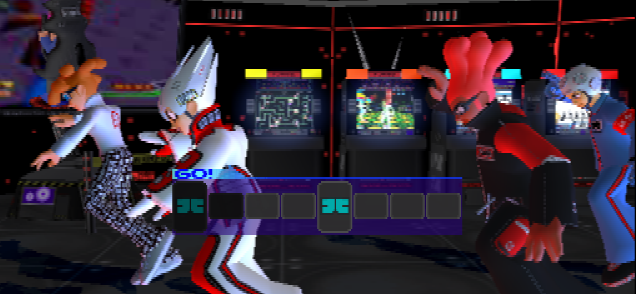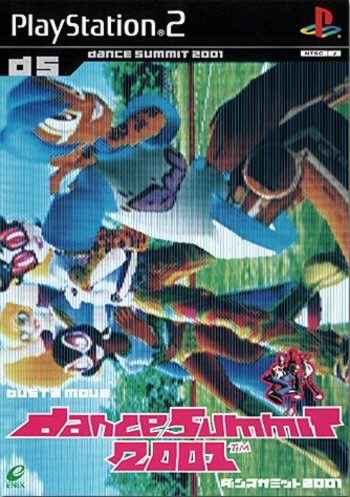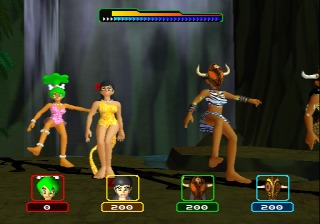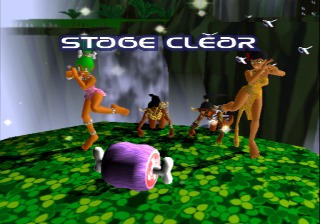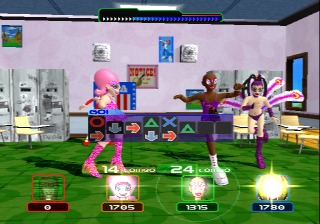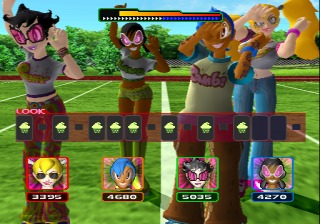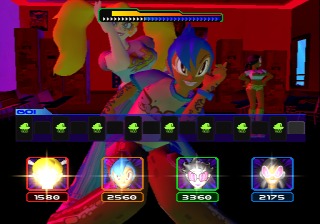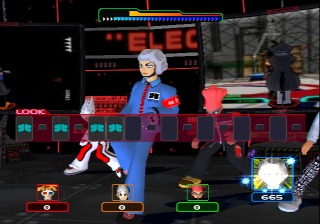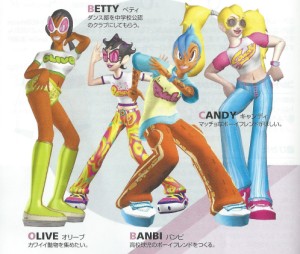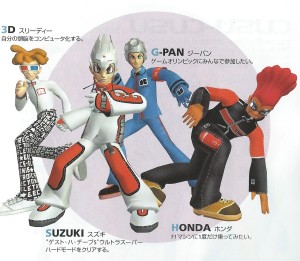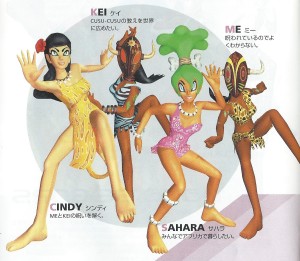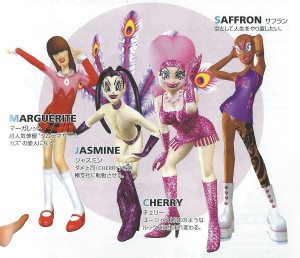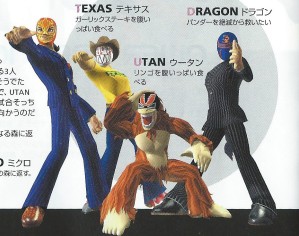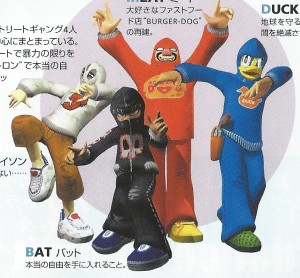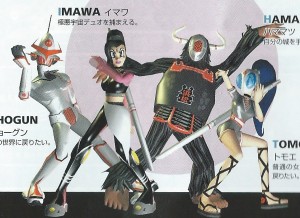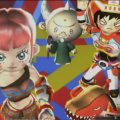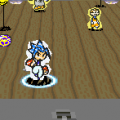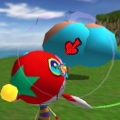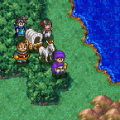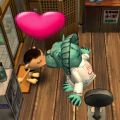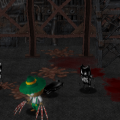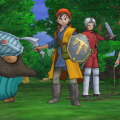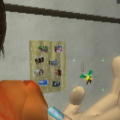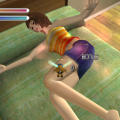- Bust A Groove
- Bust A Groove 2
- Bust a Move: Dance Summit 2001
Dance Summit 2001 is a spiritual successor to the Bust a Groove series released on the PlayStation 2. While Enix of America had published the second Bust a Groove game in the US, they had closed by the time this was released. And since Sony seemed to have no interest in the title, it was not released outside of Japan. The game is a dramatic departure from the Bust a Groove series in terms of mechanics, characters and music, going from dance battles to dance team routines. While many fans of the Bust a Groove series shy away from what Dance Summit 2001 changed, the game has its merits, as well as its failings.
The primary mechanics of DS2001 center on dance team routines. This comes with a fairly complex set of mechanics. In a typical stage, the player sees a long yellow bar at the top, indicating the dance energy of the group, as well as a series of small bars indicating the progress of the current song. At the bottom of the screen, there is a row of character portraits (with along with a box, in which one of the four face buttons appears, as well as each individual character痴 score. During each measure of the current song, a horizontal row of boxes appears in the center of the screen, some featuring icons inside, and others remaining blank. On each eighth note of the song, each box darkens, and the boxes with icons inside flash, indicating where the player must input the icons. Then, on the next measure, the player must press the face buttons according to the icons indicated prior, in a Simon Says fashion. The rows of boxes range from eight to sixteen boxes, depending on the section of the song.
The main gameplay hook is centered on competition and collaboration with the player’s chosen character and the other members of the dance team. Looking back at the center row of icons, there are “free” icons that appear in select boxes of each row, according to the color of the individual dancers. The player may pick any of the face buttons to fill that box, with the AI characters picking their own during the course of the measure. Depending on the mixture of icons that the four dancers achieve during each measure, a number of events may occur; if the dancers all pick the triangle button, for example, this is considered a Quartet icon set and a large amount of points are given to everyone. If one player picks the X button and the other characters pick the triangle button, the lone character achieves “fever” and will get a solo dance for several measures, as well as the bulk of the points. If two characters pick the same button while the other two pick different buttons, they achieve a Pair Combo and will dance together, each dancer in the pair attaining points. If two pick the square button and two pick circle, a Tag Combo is achieved, and there will be two pairs of dancers. If three characters pick the same button, it is considered a Trio Combo, and three characters dance together, each dancer gaining points. And, if none of the players pick the same button, no combo is achieved and no bonus points are given. The player must balance their goal of attaining more points than the other dance team members while collaborating with members of their dance team to keep the overall team痴 dance energy high. The overall goal of each stage is to both clear the stage with high dance energy and to become the #1 dancer of the team.
If the game wasn’t mechanically complex enough, there’s more challenge ahead: If the player has a full dance meter or performs well enough to a certain point in select songs, the song might shift into an interlude; for example, during the Queen’s High School stage interlude, the interlude consists of a whistle-driven cheerleading blitz. While some of the interludes quicken the pace, others, such as the 79 Street stage, slow the pace down. These tough interludes shake up the straightforward flow of the normal stage progression and keep the player engaged.
The game features a number of additional modes and difficulty levels. In the single player mode, here known as the Team mode, the player selects their dance team and which member of the team they’d like to play as. Then, the player goes through a series of eight stages of increasing difficulty, from 1 to 8. Up to four players (with a Multitap) may play the game at once in Team mode. Practice mode allows the player to play any of the stages at any difficulty. There is also View mode, which is an expanded version of the Dance View mode from the Bust a Groove games. Once a dance team is unlocked for View mode (by unlocking and/or playing through with them once in single-player mode), players can create their own dance routines on any of the available stages and utilizing any of the team痴 dance moves, as well as position the camera, add visual effects, and more. These routines may be saved to the memory card. Replays from the last played set of songs in Team mode may be viewed, but these cannot be saved to the memory card. Players may also unlock profiles on each dancer.
Aside from the Normal difficulty, on Easy difficulty, the player may input any arrow in any non-Free box. Returning from Bust a Groove 2 is the Mix mode. In this mode, an additional row of notes will appear on occasion, featuring the L or R buttons. The player must input the arrow or face button as well as the L or R button indicated. This mechanic adds additional challenge to the game, becoming almost ridiculous when playing on higher difficulty levels.
Giving the game even more replay value are the Remix and Bonus stages. In addition to the game’s eight regular songs, there are also eight remixed versions of these songs. These remixed stages may be selected once all eight teams are unlocked. These remixed stages are of different play lengths and structures than their counterparts. There are also two Bonus stages, available by starting the Remix version of Team mode by holding L1 and R1 before beginning this mode. When the player reaches the stages Kita2001 and Jungle Rock, a different remix than their normal remix will play. These stages may also be played by doing the same inputs when selecting the Remix tracks in the practice mode. This adds much more variety to the songlist than the standard set of tracks seen in the standard team mode.
DS2001 was an early PS2 title, and the character models show it. The characterslook like upscaled PlayStation 1 models, possessing the same cartoony style seen in the previous titles, though the game does run at a slightly higher resolution. Each team consists of four dancers, and the teams are themed along such lines as high schoolers (the School Mates), jungle dwellers (Cusu-Cusu), crossdressers (Flower Dance Team), or ravers (Data Be Bops). In total, there are eight dance teams, forming a cast of thirty-two characters. The Bust a Groove team put a lot of love into the huge cast, with each eclectic team having a lot of unique moves to show off. Unfortunately, none of the Bust a Groove dancers return as playable characters, but Hamm makes a cameo in one of the stages. At a frame rate of 60 frames per second, the dancing has never felt more fluid. The credits and the separate motion files for each dancer on the disc imply that each dancer was choreographed individually, making this game one of the most cohesive and impressive displays of motion captured dancing on the PlayStation 2.
Even if the character models are lacking, the backgrounds are more active than ever, with multiple light sources, dozens of moving objects, changing textures and more. And because the camera sweeps across all four dancers, the player is able to see all of it. Plus, like in Bust a Groove 2, most of the stages consist of several dance floors in various locations across the course of the song. One stage in particular, 79 Street, contains no less than six different stage changes during the song. The game in general is much more cinematic and music-video like than the Bust a Groove games, and a great showpiece for the early promise of the PlayStation 2痴 graphical power.
Like with Bust a Groove 2, Japanese record label FBIJ contributed to the soundtrack of Dance Summit 2001. DS2001 contains more songs than the Bust a Groove games, and the songs overall are two to three minutes longer than the average length of a Bust a Groove song. Still, the overall soundtrack doesn稚 stand out too much on a thematic level. There are not many musical surprises, with the game covering the same mix of dance, disco, hip-hop, disco, rap and such that the Bust a Groove games covered. Highlights of the soundtrack include the disco track “My Name Is Sister ‘Get'” to the sunny grooves and aggressive horns of “Red Star”. “Red Star”, in particular, is advertised in the back of the game’s manual along with the DS2001soundtrack; the ad features singer named Takaesu Miki, whose label Toshiba EMI sold the song as a single. The game’s remixes are a mixed bag, ranging from the jazz-and-breakbeats version of “Cherry Bomb” to the predictable house reimagining of “God of Funk”. There are no songs with primarily English lyrics on the soundtrack.
Also of note is the Special Controller peripheral intended for use with DS2001. Released by ASCII, this controller comes in the form of a tiny PS2 controller with two analog wires connecting to two special wrist bands; one has the square and triangle buttons; and the other has the circle and X buttons. By strapping these wrist bands on and enabling a special option in the options menu, the game omits the directional inputs and allows the player to play the game more like actual dancing, or, more accurately, by slapping the sensors against their body. This mode is fun and much more physical, but the sensors are very oversensitive and the gimmick wears off fast.
The game has a number of flaws. On higher difficulties, the game becomes almost unplayable, as full rows of eight icons appear and the player has almost no time to interpret them before it is their turn to input them. This becomes an even bigger problem on more difficult stages in Mix mode. Although the graphics are great for the time of its release, several of the dancers’ moves have them clipping their limbs through their hair or other model features. The soundtrack does not feel as fresh and iconic as the Bust a Groove games, either, with some uninspired compositions. For example, the aftermentioned “My Name Is Sister ‘Get'” has an intro that is just a pastiche of the intro to the song YMCA by the Village People. The unlockable remixes, though, are a welcome change from the series norm. The game requires even more repetition than with even Bust a Groove 2; to unlock all of the teams, remixes, and character profiles, the player must beat the game with all thirty-two dancers. With eighteen overall songs (eight stages, ten remixes), there is a lot to do, but the average player might not have the patience to play the linear team mode so many times.
Dance Summit 2001 is a very mixed bag. On the one hand, the game is a visual spectacle, with flashy, bright and colorful dancers everywhere, who interact with one another and feel vibrant and alive as they shimmy and shake across the screen. The music feeds off of this vibe and they create a party in the player’s living room. The mechanics, though, do not feel as connected to the music as the Bust a Groove games. Each chain of increasingly difficult button commands in Bust a Groove 1 and 2 felt connected to better and better dance moves for the player痴 selected character, with the overall goal of outgrooving the opponent. With Dance Summit 2001, it feels more like the player is participating in a music video shoot with the possibility of slight improvisations on an overall routine.
Dance Summit 2001 has a lot of content and a lot of great ideas. There was clearly a lot of effort put into making something original and dazzling for the PlayStation 2, and this is evident in everything the player can see and hear in the game. Still, the game requires a lot of time and patience to complete. Despite all of its shortcomings, Dance Summit 2001 is a worthy, if misunderstood, successor to the Bust a Groove series. Those who enjoyed one or both of the Bust a Groove games will find a good time here. So, if you are so inclined, round up three friends and get ready to dance.
Teams
Schoolmates
Candy, Betty. Olive, Banbi
These four junior high school girls are competing to get their dance club recognized by their school. Along with the Data Bebops, these girls are among the youngest members of the game’s cast (though Candy is 16 and still in middle school, as she flunked out of a grade). They dance in a modern pop style, which really sparkles as they dance on their school’s football field.
Data Bebops
3D, G-Pan, Suzuki, Honda
These junior high boys are obsessed with video games; most of their profiles revolve around wanting to become the best at some genre of game (though Honda wishes to become a top F1 racer). Each member exhibits impressive b-boy skills. As they break-dance, they interact with each other and perform elaborate gymnastics.
Cusu Cusu
Cindy, Kei, Sahara, Me
This group of four women are priestesses of a fictional African god named Cusu-Cusu (which sounds like the Japanese onomatopoeia for giggling). Kei and Me appear to be cursed by their lord, and wish to spread their lord’s teachings to the world, while the other two members want the curse lifted. These four women dance in an appropriately African tribal style.
Flower Dancing Team
Marguerite, Jasmine, Cherry, Saffron
These four drag queens are all employees of an unspecified high-profile corporation. Their character profiles are on the effeminate side, with Saffron in particular wanting to be reborn as a biological woman (though, if she wins, she wishes for curry by accident). These four queens have the flashiest costumes in the game, and sashay-shantay when dancing at their disco-themed stage.
Galaxy 4
Orion, Miranda, Planet, Apollo
Galaxy 4 is comprised of four space-dwellers who largely wish for war to disappear from the Earth. Their motivations for this vary, from No.02 not wanting couples to be torn apart, to No.03 just wanting all creatures in the universe to dance nonstop. These galaxy groovers dance in a funky style which would make Ulala proud.
Disco Estrus
Micro, Texas, Utan, Dragon
Disco Estrus is an especially odd team, comprising of three masked luchadores and a cartoon orangutan. If that wasn’t weird enough, “estrus” refers to a female animal phenomenon, and none of the members are female. The people in charge of naming the team probably meant to use the word “heat”. In addition, they don’t seem to dance in a disco style, mostly performing acrobatic fighting moves to the music. Still, these guys want to save animals/the environment and kick major ass on the wrestling mat of Muscle Stadium.
Jumbo Max
Jason, Bat, Meat, Duck
These four teenage roughnecks cover their faces and jump, jump, jump all night long. Their individual goals are very different from one another; Bat wishes to disappear, Jason wants to become a prettyboy, and Meat wants to bring back Burger Dog from Bust a Groove 1. In fact, two members of the classic Bust a Groove cast are mentioned in these profiles (Hamm is referred to in Meat’s profile, and Jason wants to get Strike out of prison). Jumbo Max’s members dance in a distinctly gangsta style, which makes you want to watch yourself, punk.
Far East Commander
Shogun, Imawa, Hamamatsu, Tomoe
Far East Commanders is made up of four space ninjas who fight galactic crime. In particular, they are charged by their boss Denchuu to capture the space criminal named Duo. It’s a tough job; at least two of the members seem to want to return to their home planets after their mission is complete. The four have an energetic, sensual style reminiscent of turn of the millennium pop acts.
